Related Research Articles
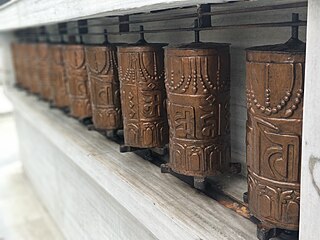
A prayer wheel, or mani wheel, is a cylindrical wheel for Buddhist recitation. The wheel is installed on a spindle made from metal, wood, stone, leather, or coarse cotton. Prayer wheels are common in Tibet and areas where Tibetan culture is predominant.

Tibetan Buddhism is a form of Buddhism practiced in Tibet, Bhutan and Mongolia. It also has a sizable number of adherents in the areas surrounding the Himalayas, including the Indian regions of Ladakh, Sikkim, and Arunachal Pradesh, as well as in Nepal. Smaller groups of practitioners can be found in Central Asia, Xinjiang, Inner Mongolia, and some regions of Russia, such as Tuva, Buryatia, and Kalmykia.

The Gelug is the newest of the four major schools of Tibetan Buddhism. It was founded by Je Tsongkhapa (1357–1419), a Tibetan philosopher, tantric yogi and lama and further expanded and developed by his disciples.

David Hykes is a composer, singer, musician, author, and meditation teacher. He was one of the earliest modern western pioneers of overtone singing, and since 1975 has developed a comprehensive approach to contemplative music which he calls Harmonic Chant. After early research and trips studying Mongolian, Tibetan, and Middle Eastern singing forms, Hykes began a long series of collaborations with traditions and teachers of wisdom and sacred art, including the Dalai Lama and the Gyuto and Gyume monks.
Buddhist culture is exemplified through Buddhist art, Buddhist architecture, Buddhist music and Buddhist cuisine. As Buddhism expanded from the Indian subcontinent it adopted artistic and cultural elements of host countries in other parts of Asia.

Buddhist music is music created for or inspired by Buddhism and includes numerous ritual and non-ritual musical forms. As a Buddhist art form, music has been used by Buddhists since the time of early Buddhism, as attested by artistic depictions in Indian sites like Sanchi. While certain early Buddhist sources contain negative attitudes to music, Mahayana sources tend to be much more positive to music, seeing it as a suitable offering to the Buddhas and as a skillful means to bring sentient beings to Buddhism.
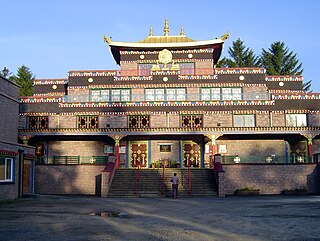
Kagyu Samye Ling Monastery and Tibetan Centre is a Tibetan Buddhist complex associated with the Karma Kagyu school located at Eskdalemuir, Scotland.
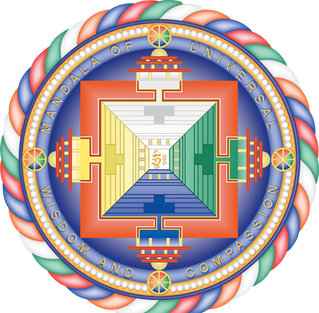
The Foundation for the Preservation of the Mahayana Tradition (FPMT) was founded in 1975 by Gelugpa Lamas Thubten Yeshe and Thubten Zopa Rinpoche, who began teaching Tibetan Buddhism to Western students in Nepal. The FPMT has grown to encompass over 138 dharma centers, projects, and services in 34 countries. Lama Yeshe led the organization until his death in 1984, followed by Lama Zopa until his death in 2023. The FPMT is now without a spiritual director; meetings on the organization's structure and future are planned.

Tashi Lhunpo Monastery is an historically and culturally important monastery in Shigatse, the second-largest city in Tibet. Founded in 1447 by the 1st Dalai Lama, it is the traditional monastic seat of the Panchen Lama.

Buddhism is the state religion of Bhutan. According to a 2012 report by the Pew Research Center, 74.7% of the country's population practices Buddhism.
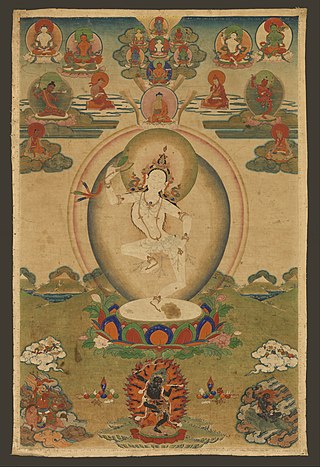
Machig Labdrön, or "Singular Mother Torch from Lab" (1055–1149), was a female Tibetan Buddhist monk believed to be a reincarnation of Yeshe Tsogyal, and the renowned 11th-century Tibetan tantric Buddhist master and yogini that originated several Tibetan lineages of the Vajrayana practice of Chöd.

Geshe Ngawang Tashi Bapu a.k.a. Lama Tashi is former Principal Chant Master of Drepung Loseling Monastery, one of the largest monasteries of the Dalai Lama. In 2006, Lama Tashi was nominated for the Grammy Award for his album "Tibetan Master Chants" in the "Best Traditional World Music". Through this achievement, he has created the record of the first Buddhist Monk for Grammy Nomination in solo performance, and the first North-East Indian to be nominated for the prestigious Grammy Award the highest honour of Music in the world. Lama Tashi led Long Life Puja Chanting for the 14th Dalai Lama, the HE 99th and 100th Gaden Tripa Rinpoches and many more highly revered masters. The Long Life Puja is a very popular traditional healing ceremony that involves a multiphonic chant performance to heal the listeners and increase their life span. Lama Tashi also led the chanting performance of the Traditional Great Prayer Festival at Bodh Gaya presided over by the 14th Dalai Lama in 2002. Lama Tashi served as the Principal and the Director of the Central Institute of Himalayan Culture Studies, Dahung, India from 2003 to 2012 and 2012-2018 respectively. While at the institute, he taught Buddhist Philosophy at University level students.

GyutoTantric University is one of the great monastic institutions of the Gelug Order.

Glenn H. Mullin is a Tibetologist, Buddhist writer, translator of classical Tibetan literature and teacher of Tantric Buddhist meditation.
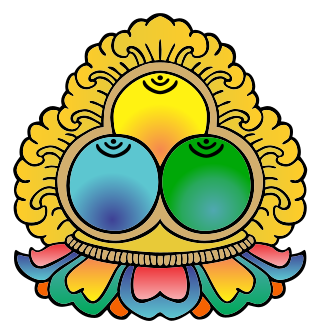
In Tibetan Buddhism, the Three Jewels and Three Roots are supports in which a Buddhist takes refuge by means of a prayer or recitation at the beginning of the day or of a practice session. The Three Jewels are the first and the Three Roots are the second set of three Tibetan Buddhist refuge formulations, the Outer, Inner and Secret forms of the Three Jewels. The 'Outer' form is the 'Triple Gem', the 'Inner' is the Three Roots and the 'Secret' form is the 'Three Bodies' or trikāya of a Buddha.
The Khamtrul tulku lineage is part of the Dongyud Palden section of the Drukpa Lineage of the Kagyu school of Tibetan Buddhism.
Karma Gon Monastery, the original monastery of the Karma Kagyu sect of Tibetan Buddhism, was founded in the 12th century by Düsum Khyenpa, the 1st Karmapa Lama in eastern Tibet at the age of 76. Karma Gon, is located on the eastern bank of the Dzachu River in Chamdo, eastern Tibet. Karma Dansa was the cradle of the karma kagyupas. When established the Karmapa had gathered 1000 monks around him here. Karma Gon was named as Karma Dansa as an administrative unit and the Chinese Ming Court enlarged the monastery’s jurisdiction by adding the Mekong’s middle and upper reaches. It was then also called Gama Dansa Si in Chinese.

Karsha Monastery or Karsha Gompa is a Buddhist monastery in the Padum Valley of the Zanskar region of the union territory of Ladakh in northern India. The Doda River flows past the monastery from its source at the Drang Drung Glacier of the Pensi La. It was founded by the translator Phagspa Shesrab. The monastery, also known by the name Karsha Chamspaling, was founded by Phagspa Shesrab, under the Gelugpa Order or Yellow Hats. It is 11 km north of Padum in Zanskar River valley.
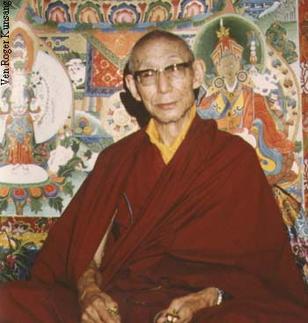
The Third Trijang Rinpoche, Lobsang Yeshe Tenzin Gyatso (1901–1981) was a Gelugpa Lama and a direct disciple of Pabongkhapa Déchen Nyingpo. He succeeded Ling Rinpoche as the junior tutor of the 14th Dalai Lama when the Dalai Lama was nineteen years old. He was also a lama of many Gelug lamas who taught in the West including Zong Rinpoche, Geshe Rabten, Lama Yeshe, Kelsang Gyatso, and Lama Zopa Rinpoche. Trijang Rinpoche's oral teachings were recorded by Zimey Rinpoche in a book called the Yellow Book.
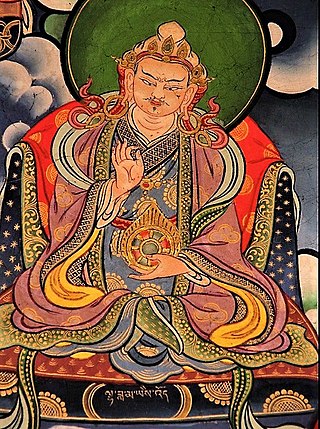
Yeshe-Ö was the first notable lama-king in Tibet. Born as Khor-re, he is better known as Lhachen Yeshe-Ö, his spiritual name.
References
- ↑ Rosenbloom, Stephanie: What's the Buzz? Sound Therapy The New York Times. November 24, 2005
- ↑ Ear Wars and the Ultimate Om Arkansas Democrat Gazette. June 10, 2010
- ↑ History of the Sound Healers Association
- ↑ 100 Spiritual Power List Watkins Review. Issue 26, Spring 2011
- ↑ Thich Nhat Hanh Chanting from the Heart Parallax Press; 2006. ISBN 1-888375-63-9
- ↑ Tibetan Monk Nominated for Grammy Archived 2010-01-02 at the Wayback Machine www.phayul.com. December 10, 2005
- ↑ Grammy nomination for Buddhist monk The Hindu. January 26th, 2006
- ↑ I am only a monk "Medicine Buddha" at Shoreline Ampetheatre, May 17–20, 2001
- ↑ All Music Guide: Chakra Dance, 2004